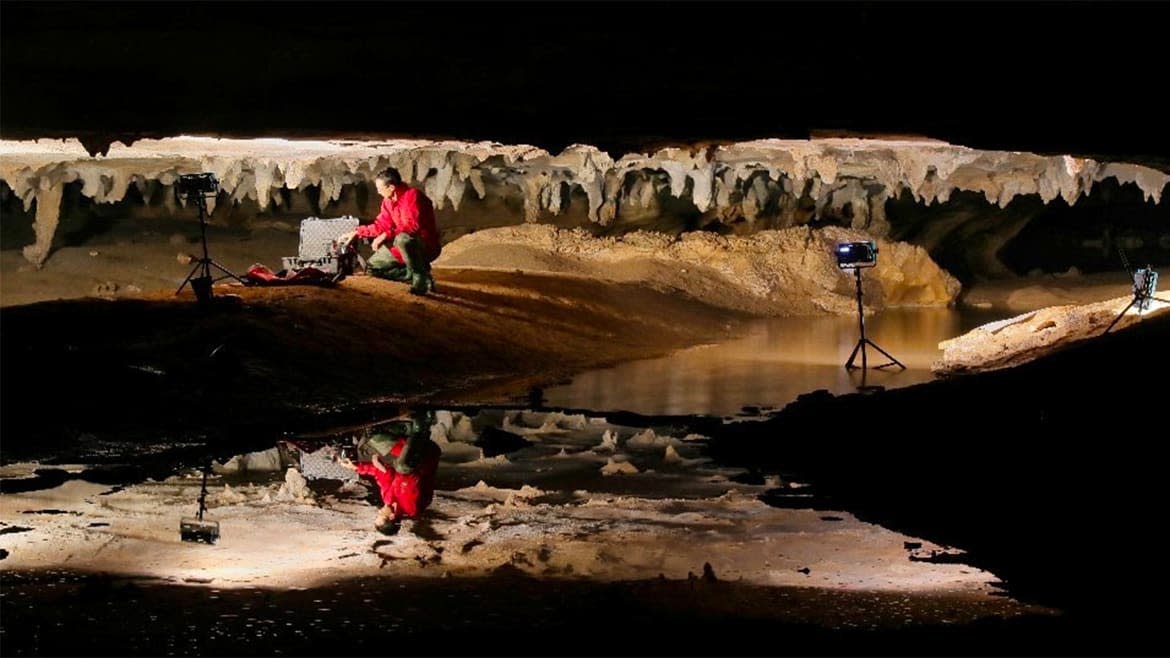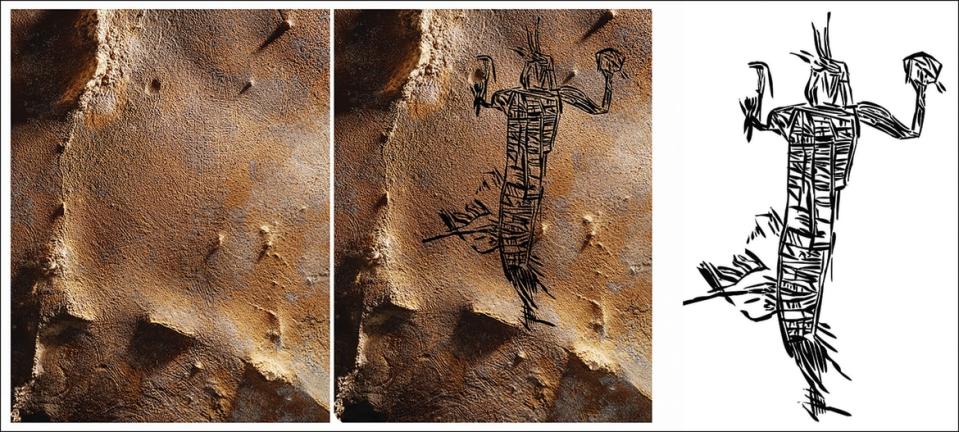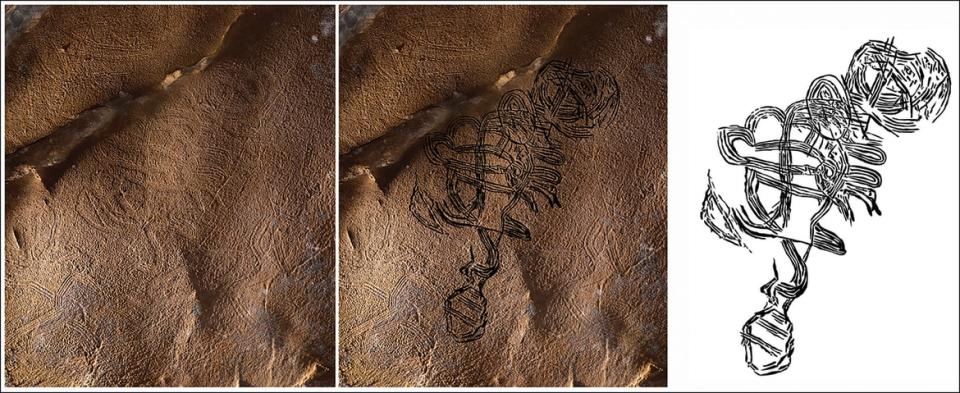3D Tech Is Helping Archaeologists Unearth Ancient Indigenous Art

- Oops!Something went wrong.Please try again later.
In the darkness of the 19th Unnamed Cave, you have to crawl. While the chamber is wide, it is vertically quite small—there’s enough space for a squat. You must lay on your back to look at the ceiling. What you can see in a single moment is incredibly limited by these natural restrictions. Yet, the extreme nature of the 19th Unnamed Cave makes the massive ancient artwork etched there all the more amazing.
In a study published Wednesday in the journal Antiquity, researchers detail five figures incised onto the mud veneer of the cave ceiling, located in an undisclosed place in Alabama. The art was created during what’s known as the Woodland Period by Indigenous Americans some time between 600 and 1,000 A.D. Their descendants belong to the Chickasaw Nation, the Cherokee Nation, the Choctaw Nation, and the Muscogee Creek Nation, among possibly others.
These figures, described as mud glyphs, are thought to be the largest known cave art images identified yet in North America. The largest is an 11-foot-long serpent resembling an eastern diamondback rattlesnake—a creature sacred to Southeast Indigenous people. Slightly smaller yet more mysterious are three anthropomorphic figures which do not resemble known characters from Southeast Native American stories. The final figure is six feet of swirling loops; it is not known what it represents.
What is known is that these caves are regarded as sacred places by Native Americans in the American Southeast—considered pathways to the underworld. This is why researchers theorize that the anthropomorphic figures may have been spiritually important.
These massive figures are also described in the study as “invisible.” The cave is so cramped, and etchings so faint, that the artwork was overlooked when researchers entered the chamber more than 20 years ago. To solve this, the study team used a technique known as high-resolution 3D photogrammetry to digitally manipulate the chamber space and reveal the artwork.

Anthropomorphic figure in regalia from 19th Unnamed Cave, Alabama.
Photogrammetry involves taking many overlapping photographs from many angles and using these to create a 3D model through software. It’s a method developed in the 19th century as a way to turn aerial photographs into topographical maps. But subsequent breakthroughs in computer science and digital photography allowed the process to turn into what it is today—a technique for producing photorealistic models that can be digitally manipulated in a virtual space.
This new study marks the first time this team has used 3D photogrammetry to analyze an ancient cave like this. They argue this technology offers “untapped potential” for documenting and identifying further “archeological phenomena.”
These massive figures have long challenged the human eye; the size of the cave also suggests the artists could not see their work in its entirety while they created it. Instead, they must have gone into the cave “with a composition already in their mind’s eye,” Jan Simek, first author of the study, told The Daily Beast. The lines are too well-defined and purposefully placed to simply be doodles.
Simek is a cave archaeologist and a professor at the University of Tennessee, Knoxville. He’s been aware of the 19th Unnamed Cave since co-author Alan Cressler, a caver and independent researcher, came across the site in 1998 and saw hundreds of much smaller mud glyphs also on the ceiling—carvings of geometric shapes, wasps, and birds. What Cressler could not see, however, were these much larger figures—that is, until the team utilized 3D photogrammetry years later.
“We have been doing this work for 35 years and we’ve seen lots of very impressive things,” Simek said. “But we didn’t anticipate seeing figures of this size, especially the human-like figures. When we did it was a remarkable experience because all of a sudden we became aware that this cave was much more complicated than we realized.”
Technology is advancing archeology at a rapid clip, Simek said. Tools like lidar, a remote-sensing method, and satellites are allowing teams around the world to view the previously hidden. Photogrammetry as a field has also advanced over the last decade—so much so that co-author Stephen Alvarez, a National Geographic photographer and founder of the Ancient Art Archive, made a case to Simke and Cressler for returning to the cave in 2017.
Over the course of two months, the study team took 16,000 photographs—each shot overlapping the other by 60 to 80 percent. These were used to create three 3D models: two of the engraved ceiling, and one of another chamber without art. (The 19th Unnamed Cave is just one part of three miles of underground passageways.) Digital manipulation of the models, in turn, allowed for an unencumbered view of the ceiling.
“You can move the floor and you can move the ceiling in a way that you can’t in reality,” Simek said. “It gives us a much broader field of vision.” This process, and the viewpoint it allows, revealed the ceiling’s faint lines were actually incisions corresponding to intricate pieces of art.
“The sheer number of images collected from the 19th Unnamed Cave and the overlays created enables us to see the big picture, so to speak, and to see it in richer detail than previously possible,” Julie Reed, an associate professor at Penn State who wasn’t a part of the study team, told The Daily Beast.
Reed is also a historian with an emphasis on Southeastern Indians and Cherokee History, and a citizen of the Cherokee Nation. While she wasn’t involved with this project, she has visited other caves with members of the study team. So far, Simek and colleagues have visited around 2,000 caves across Tennessee, Georgia, Kentucky, and Alabama. They’ve seen art within 100 of those caves.
Reed observes that artist-laborers during the Woodland Period also created the Serpent Mound, a 1,000-foot-long effigy and burial site, in present-day Ohio. The artistic imagination and thematic choices observed both there and in the 19th Unnamed Cave remind us “of the ways our Indigenous forebears spoke similar creative and spiritual languages to each other across time and space,” Reed said.

Enigmatic figure of swirling lines, with a round head at one end and a possible rattlesnake tail at the other from 19th Unnamed Cave, Alabama
The study team was also eager to use 3D photogrammetry because you can, with little effort, turn the data into a VR experience, Simek said. In the paper, the team discusses the potential of bringing these virtual experiences to descendant communities. They’ve already presented the initial results to the Eastern Band of Cherokees—though the 19th Unnamed Cave project did not directly involve Native people.
(The study team is working on another paper on a different Alabama cave with members of the Louisiana Coushatta tribe. They’ve also partnered with the Chickasaw Nation to document rock art in their homeland.)
“The ‘access’ provided by 3D photogrammetry without physically entering the cave can’t be overstated,” Reed said.
“As someone who has been into caves containing early Cherokee syllabary, I regularly think about how we can bring the documents and physical space to Cherokee elders who are the expert speakers and readers of the language,” she added.
Access, in regards to the Unnamed 19th Cave, is complicated on a number of levels. It is referred to as such to keep its location anonymous: It is unprotected and located on private land. “Security is a real concern,” said Simek, who fears damage and looting.
Arizona Duo Charged With Climbing Sacred Native American Site
It is also not on land legally possessed by a tribe. Around 1813, a settler movement led by Andrew Jackson resulted in illegal land sales and squatter claims on Native-owned property in Alabama. The subsequent passage of the devastating Indian Removal Act of 1830 forcibly removed approximately 125,000 members of Southeastern tribes from their land.
Today, about two-thirds of the 100 cave sites identified by Simek and colleagues are located on private land—and they are very difficult to access, both because of their legal status and the simple fact that they are hard to physically get to. Universal access, however, isn’t necessarily the ultimate goal for these sites. Instead, we should “consult with descendant communities today in order to avoid the extractive nature of relationships that has long been associated with non-Native interest in Indigenous lands, cultures, and histories,” Reed said.
While the question of access remains unresolved, Simek plans to continue searching for more cave art. There are an estimated 25,000 caves in the American Southeast, and only 2,000 have been examined for cave art. He’s also eager to reexamine sites with 3D photogrammetry; he thinks it’s very likely there might be art they’ve missed.
“I’m about to retire from my faculty position, but I’m not going to stop doing this,” Simek said. “There’s so much work to do.”
Get the Daily Beast's biggest scoops and scandals delivered right to your inbox. Sign up now.
Stay informed and gain unlimited access to the Daily Beast's unmatched reporting. Subscribe now.

